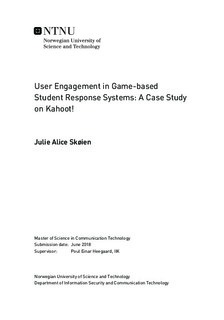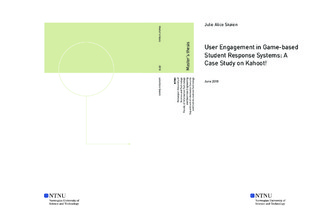| dc.description.abstract | Among all the new applications and services coming, are technological tools one can benefit from, in fields such as educational environments. The increased use of technology in schools has opened up for new ways of learning, particularly learning by digital interactions in classrooms which, in turn, make students take more active part in lectures. The enabling of digital interactions can be accomplished by using educational technology such as student response systems (SRS). Beyond their ability to both enhance learning and increase student attendance in class, these systems also have the ability to trigger engagement among students. One of such SRS is the popular quiz-based application Kahoot!. By having elements from traditional games integrated to its design, Kahoot! has been able to trigger great engagement in classrooms, and, for some, even made learning fun.
As a contribution to the existing literature on user engagement, the concept of user engagement in the context of SRS has been investigated in this thesis. This has been done by looking at the game-based SRS (GSRS) Kahoot!, as a concrete case. To identify which elements contribute to user engagement and which elements form barriers in a GSRS, elements that trigger and influence the user engagement in Kahoot!, specifically, has been focused on. Further, the role that technical factors potentially play in this respect has been examined. To this end, a mixed methods research design has been adopted. More concretely, a literature review, semi-structured interviews with two SRS developers, and a larger-scale study based on an electronic questionnaire (N=106) have been conducted. This thesis presents the background and related work for this research, the methodology used to carry out the research, results from conducting the three studies, and finally discussions and conclusive remarks.
The main findings indicate that both students and teachers highly engage when using Kahoot!. Especially the feeling of being drawn into/involved in the experience (Felt Involvement) with Kahoot! is very high. Thus, the role one has when playing/using Kahoot! - student or teacher - does not significantly affect the felt level of engagement. Moreover, a range of factors - categorized into either Human, System or Context Influencing Factors - that influence user engagement positively or negatively were identified. These factors can also be understood by viewing them in the light of six key engagement attributes suggested by previous work in the field of user engagement (Perceived Usability, Focused Attention, Felt Involvement, Endurability, Novelty and Aesthetic Appealing). Among negatively influencing factors, are technical issues, such as bad Internet connection or experienced delay. However, even though many respondents had experienced technical problems with Kahoot!, this did not seem to significantly affect their level of engagement with Kahoot!. %Observations and further testing did not result in any significant differences in user engagement when a technical issue, specifically "bad Internet connection", is experienced or not. The findings thus indicate that Kahoot! is perceived as highly engaging and that negatively influencing factors, e.g., technical issues, might influence a certain engaging experience, but that in the long run, these do not seem to be affecting users' "top of mind" impression of Kahoot!. | |

